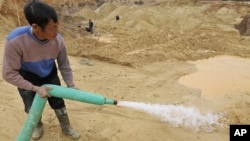Last week, China’s biggest producer of rare earths elements suspended production to try to boost prices for the 17 minerals essential for manufacturing modern technologies. Although China currently has a near monopoly on these crucial resources, its dominance could soon be challenged as trade partners lose patience with the manipulation of the supply chain.
Former Chinese leader Deng Xiaoping declared in 1992 that “The Middle East has its oil, China has rare earths.” Chinese companies have strongly pursued the rare earths mining business since and now account for about 95 percent of the world’s total rare earth supplies. The state-linked Baotou Group is responsible for more than 60 percent of that output.
Last week, its management said it is suspending production to stabilize the market and balance supply and demand. The move followed a roughly 20 percent drop in rare earth prices in recent months.
Risk list
Andrew Bloodworth is the head of science at the British Geological Survey. His team recently compiled the 2011 international ‘Risk List’ of chemical elements.
The list gives an indication of the threat to supplies of those elements and element groups necessary to drive global economic development.
Bloodworth says although rare earths are available to be mined outside China, the key issue for mining businesses is the cost of separating the element from its ore.
“The Chinese can do it more cheaply than anyone else, which has meant historically, the price of rare earths has fallen, which has put mines in other parts of the world out of business," Bloodworth said. "So, we’re in a situation now where we have a near monopoly situation in terms of supply and rising demand, and people are very concerned that China has dominance in these things.”
Strategic manipulation
China has history when it comes to manipulating rare earth prices by restricting supply, having implemented a similar moratorium in 2008.
Beijing demonstrated it is willing to use its market dominance as a foreign policy pool when in October 2010, China halted shipments to Japan during a territorial dispute with Tokyo.
That same month, the U.S. Department of Defense debated the national security implications of Chinese control of the rare earths market because key technologies including radar and smart bombs require the material.
Weeks later, the U.S. Energy Department published its Critical Materials Strategy. This called for a strategic expansion of rare earth supplies and warned significant harm could be caused to the United States - which was once self-sufficient in rare earth production - if supplies to high-tech manufacturers were interrupted.
Market reaction
Unlike previous occasions when Beijing has manipulated supply, the world is now looking increasingly prepared to move away from its dependence on Chinese rare earths.
Manufacturers, including Toyota and General Motors, are already developing processes that minimize the use of rare earths in vehicle design, says Matthew Fusarelli, head of research at AME.
“Rare earths generally have a very high degree of substitutability," Fusarelli said. "So electronics manufacturers can, over time, change their production processes to use rare earths more sparingly, if at all.”
Andrew Bloodworth says it will not take many new suppliers to alter the dependence on China.
“The amount we use compared to industrial metals is absolutely tiny," he explained. "Last year in the world we mined about 17, 18 million tons of copper. We mined about 130,-140,000 tons of rare earth. A couple of new mines will change the picture completely.”
Alternatives
New mines are being planned in the United States, Russia and Australia. Other mines once moth-balled or not developed on concerns about viability are moving towards production.
Among these is the Molycorp mine in Mountain Pass, California. This closed in 2002 when China swamped the market with cheap supplies.
Molycorp directors say they have discovered several new rare earth deposits at the site and expect the old mine to be one of the world’s largest rare earth suppliers by 2014.
Manipulation of China's Rare Earth Minerals Supply Could Backfire








